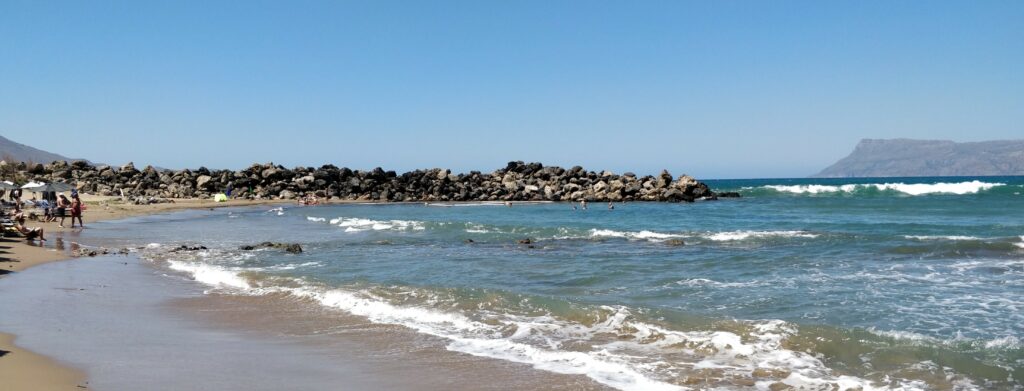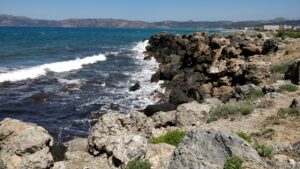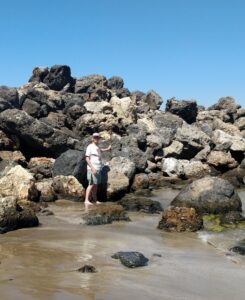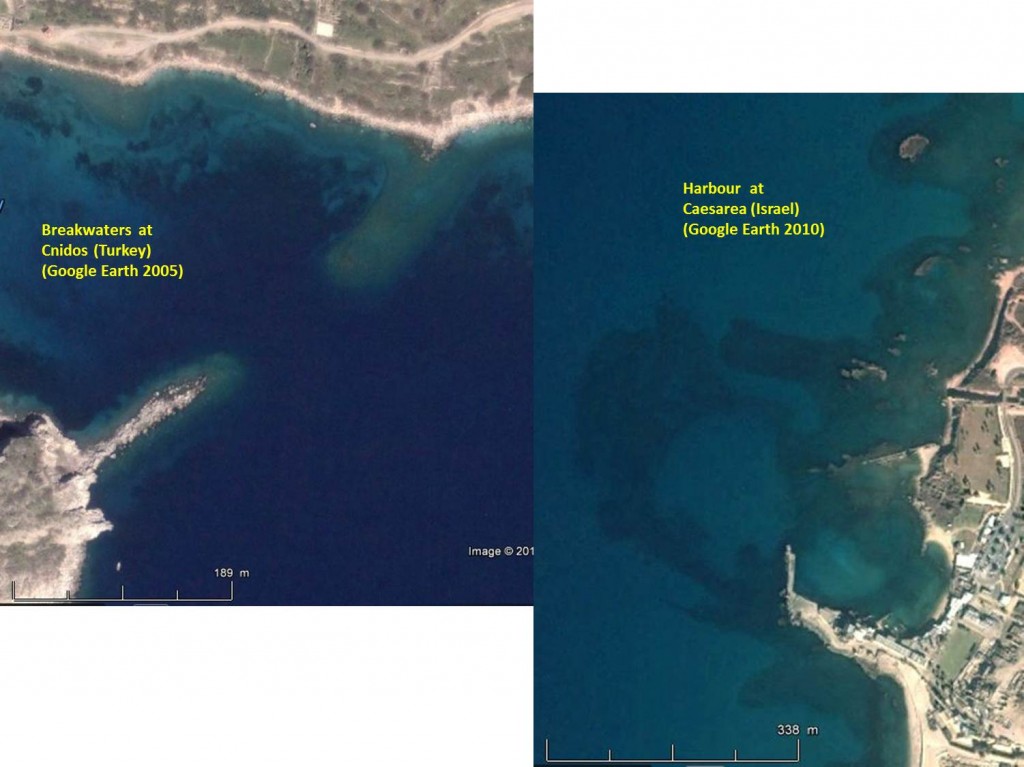Rubble-mound breakwaters consist of piles of stones more or less sorted according to their unit weight: smaller stones for the core and larger stones as an armour layer protecting the core from wave attack.

This kind of structure has been around for over 2500 years and modern coastal engineers still build them to create harbours sheltered from wave penetration. It was widely used for breakwaters in water deeper than a few meters where positioning of ashlar headers by divers was difficult. Ancient breakwaters may have been over- or undersized and the result is that only a few breakwaters have been luckily preserved, while many others are now found under water as “submerged breakwaters”, as a consequence of 2000 years of storms.
Without going into the details of breakwater design, it can be understood easily that stability of a structure made of stones depends primarily on the stone size in relation to the strength of wave action: breakwaters in open waters exposed to storms acting on large areas and therefore inducing high waves, must consist of larger stones than breakwaters located in sheltered areas.
A study was carried out to find some simple relation between the governing parameters (water depth, structure height, stone size) and the equilibrium position of the crest of rubble mound breakwaters subject to long term wave attack in breaking wave conditions.
It was concluded that undersized emerging rubble mound breakwaters reduce to submerged breakwaters and that, for a given stone size, submerged breakwaters stabilise to a predictable crest level after long term wave attack in breaking wave conditions.
We must also remember that the MSL rose about 0.5 m since antiquity, so that breakwaters that were stable at that time in shallow water (a few meters water depth) may not be stable anymore because larger waves can reach them nowadays. In tidal areas, the worst conditions for stability are when the largest waves occur together with the highest water level. The probability of occurrence of this happening is smaller than for a fixed water level, but that may not change the final result for stability in the long term.
Careful examination of historical Google Earth images enables us to see quite a few breakwaters in shallow waters, which are collected together with some other pictures made on site, into a pdf document “Ancient breakwater remains“.
Some remarkable ancient rubble mound breakwaters can be listed as follows:
- Portus (Fiumicino, Italy): deepest section of the 3200 m long breakwaters, now inland;
- Pharos (Alexandria, Egypt): over 2300 m long, submerged in open water;
- Thapsus (Bekalta, Tunisia): about 1100 m long, submerged in open water;
- Eretria (Eretria, Evia, Greece): at least 600 m long, submerged in sheltered water;
- Paphos (Kato Paphos, Cyprus): about 600 m long, with a parallel one 200 m long, submerged in open water;
- Leukas/Ligia (Lefkada island, Greece): about 540 m long, submerged in sheltered water;
- Pythagoreion (Samos island, Greece): about 480 m long, submerged in open water;
- Chersonesos (Cape Agami, Egypt): about 400 m long, submerged in open water;
- Eleusis (Vlychada, Santorini): about 360 m long, submerged in open water;
- Sullecthum (Salakta, Tunisia): about 350 m long, submerged in open water;
- Tieion (Filyos, Turkey): over 350 m long, submerged in open water;
- Mytlilini (Lesbos island, Greece): about 350 m long, submerged in sheltered water;
- Sabratha (Libya): about 320 m long, submerged in open water;
- Leptis Magna (Lebda, Libya): about 300 m long, berm breakwater in open water;
- Methone (Modon, Greece): about 250 m long, submerged in fairly open water;
- Neftina (Lemnos island, Greece): about 200 m long, submerged in open water;
and many others, smaller ones.
Obviously, questions remain on many of these structures, e.g. is the structure at Emporia (Spain) a breakwater or a city wall falling into the sea? Was the Thapsus (Tunisia) structure a rubble mound breakwater or a vertical breakwater? Is the Kainopolis (Libya) feature a breakwater or just some beach rock? etc. etc.
An index of all breakwaters collected here is given hereafter and everybody is welcome to send me more information and pictures on ancient breakwater remains …
- Abdera, GE 2019 (Avdira, Greece)
- Acholla, GE 2018 (Ras Boutria, Tunisia)
- Adramyttium GE 2019 (Ören, Turkey)
- Akko, GE 2010 (Acre, Israël)
- Amathonte, GE 2003 (Amathonte, Cyprus)
- Andros, GE 2003 (Andros island, Greece)
- Anthedon, GE 2003 (Anthidonia, Greece)
- Anthedon, GE 2015 (Anthidonia, Greece)
- Antissa, GE 2002 (Lesbos island, Greece)
- Antium, GE 2010 (Anzio, Italy)
- Apollonia, GE 2010 (Susah, Libya)
- Assos, GE 2006 (Assos, Turkey)
- Astura, GE 2016 (Torre Astura, Italy)
- Baiae, GE 2007 (Baia, Italy)
- Caesarea Germanica, GE 2013 (Kapanca, Turkey)
- Caesarea, GE 2010 (Caesarea Maritima, Israël)
- Caieta, GE 2013 (Spiaggia di Fontania, at Gaeta, Italy)
- Calpe, GE 2013 (Kerpe, Turkey)
- Carpis, GE 2009 (Sidi Raïs, Tunisia)
- Carthage, Falbe, GE 2015 (Carthage, Tunisia)
- Carthage, Magon, GE 2020 (Carthage, Tunisia)
- Charmothas, GE 2017 (Sharm Yanbu, Saudi Arabia)
- Cheimerion, GE 2006 (Amoudia, Greece)
- Chersonesos, GE 2020 (Cape Agami, Egypt)
- Chersonisos, GE 2002 (Hersonissos, Crete)
- Circei, GE 2014 (Cape Circeo, Italy)
- Cisamo, GE 2013 (Kissamos-Kastelli, Crete)
- Cisamo, Hampsa 2006 (Kissamos-Kastelli, Crete)
- Corycus, GE 2004 (Kizkalesi, Turkey)
- Daskyleion, GE 2011 (Ergili, Turkey)
- Delion, GE 2010 (Delesi, Greece)
- Delos, GE 2004 (Delos island, Greece)
- Dia insula, GE 2013 (Isle of Dia, Crete)
- Elaia, GE 2016 (Kazikbaglar, Turkey)
- Elaious, GE 2009 (Abide, Turkey)
- Eleusis, GE 2018 (Vlychada, Santorini island, Greece)
- Emporia city wall, de Graauw 2008 (Sant Marti d’Empuries, Spain)
- Emporia city wall, GE 2009 (Sant Marti d’Empuries, Spain)
- Enopia, GE 2011 (Egina island, Greece)
- Epidauros, GE 2013 (Epidauros, Peloponnesus)
- Eretria, GE 2018 (Eretria, Evia, Greece)
- Galata, GE 2016 (Galata, Bulgaria)
- Gigthis, GE 2010 (Bou Ghrara, Tunisia)
- Gythion, GE 2013 (Gythio, Peloponnesus)
- Hadrianou Hormos, GE 2018 (San Cataldo, Italy)
- Hadrumete, GE 2014 (Sousse, Tunisia)
- Halicarnassus, Flemming 1969 (Bodrum, Turkey)
- Halicarnassus, GE 2006 (Bodrum, Turkey)
- Halieis, GE 2021 (Portocheli, Peloponnesus)
- Hephaistia, GE 2009 (Lemnos island, Greece)
- Hierapytna, GE 2010 (Ierapetra, Crete)
- Hieros Limen, GE 2014 (Kamaraki-Vlastos, Greece)
- Hipponium, GE 2016 (Spiaggia di Trainiti, Italy)
- Iassos, GE 2002 (Kıyıkışlacık, Turkey)
- Iol-Caesarea, GE 2003 (Cherchel, Algeria)
- Iol-Caesarea, GE 2013 (Cherchel, Algeria)
- Kainopolis, GE 2004 (Maaten al Uqla, Libya)
- Kane, GE 2006 (Karadag, Turkey)
- Karthaia, GE 2018 (Kea island, Greece)
- Kenchreai, GE 2013 (Kenchreai, Peloponnesus)
- Klazomenae, GE 2002 (Liman Tepe, Turkey)
- Klazomenae, GE 2006 (Karantina island, Turkey)
- Klazomenae, Sahoglu 2011 (Liman Tepe, Turkey)
- Knidos, GE 2005 (Cnide, Turkey)
- Kossura, GE 2012 (Pantelleria, Italy)
- Kourion, GE 2011 (Episkopi Phaneromeni, Cyprus)
- Kyllene, GE 2015 (Killini, Peloponnesus)
- Kyme, GE 2006 (Nemrut Limani, Turkey)
- Larymna, GE 2014 (Incirli Ada, Turkey)
- Lasea, GE 2004 (Chrysostomos, Crete)
- Lechaion, GE 2017 (Lechion, Peloponnesus)
- Leptiminus, GE 2011 (Lamta, Tunisia)
- Leptis Magna, de Graauw 2005 (Lebda, Libya)
- Leptis Magna, GE 2016 (Lebda, Libya)
- Leukas, GE 2012 (Lefkas island, Greece)
- Leuke Akte, GE 2018 (Ras Kanayis, Egypt)
- Magydos, GE 2007 (Antalya, Turkey)
- Maritima Civitas Colonia, GE 2003 (Les Laurons, France)
- Megara Hyblaea, GE 2007 (Banchinamento Orsi, in Augusta harbour, Sicily)
- Methone, GE 2013 (Modon, Peloponnesus)
- Misenum, GE 2007 (Miseno, Italy)
- Mitylene, GE 2006 (Lesbos island, Greece)
- Myndus west, GE 2018 (Gümüslük, Turkey)
- Myndus, GE 2011 (Gümüslük, Turkey)
- Myrina, GE 2006 (Aliaga, Turkey)
- Neftina, GE 2009 (Lemnos island, Greece)
- Nesis, GE 2007 (Nisida, Italy)
- Nirou Khani, GE 2011 (Crete)
- Nora, GE 2013 (Capo di Pula, Sardinia)
- Sybola? GE 2021 (Ölüdeniz, Turkey)
- Paphos, GE 2017 (Paphos, Cyprus)
- Paros, GE 2013 (Paros island, Greece)
- Paros, Naoussa bay, GE 2019 (Paros island, Greece)
- Pharos, GE 20/1/2017 (Alexandria, Egypt)
- Phaselis, GE 2002 (Tekirova, Turkey)
- Phaselis, GE 2013 (Tekirova, Turkey)
- Pisa, GE 2012 (Pisa-San Rossore, Italy)
- Plakia, GE 2017 (Kursunlu Manastir, Turkey)
- Plakias Beach, GE 2015 (Plakias, Crete)
- Pogonia, GE 2017 (Palairos, Greece)
- Pompeiopolis, GE 2004 (Viransehir, Turkey)
- Populonio, GE 2017 (Populonia, Italy)
- Portus Domitianus, GE 2013 (Santa Liberata, Italy)
- Portus Julius, GE 2007 (Lucrino, Italy)
- Portus, de Graauw 2011 (Fiumicino, Italy)
- Portus, GE 2007 (Fiumicino, Italy)
- Psyra, GE 2010 (Psara island, Greece)
- Ptolemais, GE 2009 (Tolmeita, Libya)
- Ptolemais, GE 2015 (Aynaligöl bay on Cape Figla, Turkey)
- Pullaria, GE 2007 (Brioni island, Croatia)
- Puteoli, GE 2017 (Pozzuoli, Italy)
- Pyrgi, GE 2006 (Santa Severa, Italy)
- Pythagoreion, GE 2014 (Samos island, Greece)
- R’mel, GE 2021 (R’mel, Tunisia)
- Ramla Beach, GE 2017 (Gozo, Malta)
- Rhenaia, GE 2014 (Rinia island, Greece)
- Sabratha, GE 2013 (Sabratha, Libya)
- Saguntum, GE 2011 (Grao Vell at Sagunto, Spain)
- Salamis, GE 2008 (Salamine island, Greece)
- Sami, de Graauw 2013 (Kefalonia island, Greece)
- Sami, GE 2017 (Kefalonia island, Greece)
- San Marco di Castellabate, GE 2007 (Italy)
- Saturnum, GE 2015 (Torre Saturo, Italy)
- Seleukia Pieria, GE 2008 (Seleukia, Syria)
- Side, GE 2011 (Selimiye, Turkey)
- Sidi Daoud, GE 2010 (Sidi Daoud, Tunisia)
- Sidi Daoud, GE 2014 (Sidi Daoud, Tunisia)
- Silvium, GE 2013 (Savudrija, Istria, Croatia)
- Sirakayalar, GE 2013 (Turkey)
- Skiathos, GE 2016 (Skiathos island, Greece)
- Sotiras, GE 2009 (Lemnos island, Greece)
- Syllectum, GE 2012 (Salakta, Tunisia)
- Thanos, GE 2009 (Lemnos island, Greece)
- Thapsus, GE 2009 (Bekalta, Tunisia)
- Thassos, GE 2009 (Thassos island, Greece)
- Tieion, GE 2012 (Filyos, Turkey)
- Tyr south, GE 2019 (Sour, Lebanon)
- Wadi al-Jarf, GE 2004 (Gulf of Suez, Egypt)


